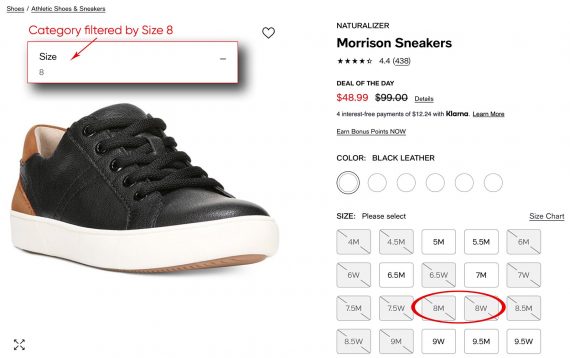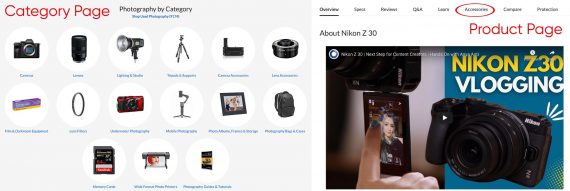The first step is identifying direct competitors. If your business model is low prices, Amazon and Walmart are competitors. If it’s quality and community over price, the field narrows. And don’t ignore brands that target your audience with similar products.
Don’t fall into the trap of merely copying competitors. Take advantage of their weak spots.
Strengths and Weaknesses
For example, reviewing the product pages of Macy’s reveals a big mistake: sneakers that aren’t available in a chosen size. It wastes shoppers’ time.
Spying tools typically reveal brand sentiment, pricing strategies, and estimated revenue. However, the best assessment of strengths and weaknesses comes from elbow grease — in-depth, manual analysis.
Consider what other brands do right and wrong. Identify weak spots. The goal is to give competitors’ customers reasons to switch to your company.
- Shop their store. Study the layout, design, navigation, search functionality, product page features, and checkout. Are they providing enough information? Is the primary call-to-action apparent? Is finding items easy? Those are just a few questions among many. fhpcn
For direct competitors:

 Remember to analyze the impact of new products and features to find what works. Implement a feedback form or survey for customers and prospects. Remind them to share shopping stories in their social circles, generating valuable word-of-mouth traffic.
Remember to analyze the impact of new products and features to find what works. Implement a feedback form or survey for customers and prospects. Remind them to share shopping stories in their social circles, generating valuable word-of-mouth traffic.
- Check product ratings and reviews. Do competitors deploy reviews and Q&As to enhance product descriptions? Do they respond to negative feedback?
- Subscribe to emails and text messages. Learning how competitors interact with customers helps understand their success. But there’s a good chance you’ll find room for improvement.
- Identify their value proposition. According to Statista, Amazon spent more than $32 billion on marketing in 2021. The rest of us need to give shoppers reasons to buy. Are your competitors explaining the value of what they sell?
- Detect gaps in inventory and presentation. Many stores can benefit from relevant add-ons, accessories, and similar products. Photography-equipment retailer Adorama features not just cameras but also lenses, lighting, tripods, memory cards, specialty printers, and digital photo frames. However, the site buries all those accessories in a tab easily missed.

 Macy’s makes the mistake of displaying out-of-stock product sizes on filtered categories.
Macy’s makes the mistake of displaying out-of-stock product sizes on filtered categories.
- Locate conversion tools. Use Builtwith.com or similar to see everything that loads on the site, including live chat and behavioral third-party scripts. Then research better tools to improve.
- Pinpoint social proof. Most consumers, when uncertain, follow the crowd. That’s why top brands hire influencers and experts to tout products. But don’t underestimate the power of everyday shoppers. Sites without customer reviews and testimonials are missing the boat.
- Evaluate support, service, and warranty info. People want to know how they obtain assistance if something goes wrong.
Don’t Copy
Adorama’s “Accessories” tab at the top right is easily overlooked.
Keeping an eye on competing stores is crucial for staying ahead. Just as search engine strategists use competitive analysis, the best conversion specialists monitor rival sites for tactics to attract and retain buyers.


